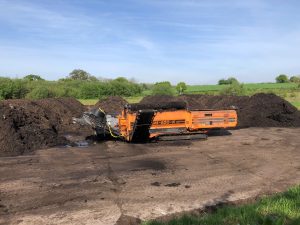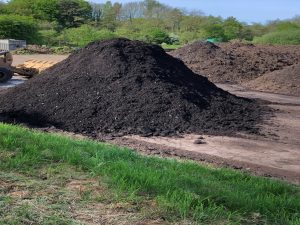Modern alchemy: transforming garden waste into valuable soil conditioner – by John Box CEcol CEnv FCIEEM(rtd)
Lawn mowings, weeds, dead plants and woody prunings often go into the garden waste bins that are part of our regular bin collections.
Veolia collect the household and commercial waste for Telford and Wrekin Council where I live and they run the household recycling centres where you can take household rubbish including garden waste. The garden waste from the kerbside collections and the recycling centres goes to their composting site on the edge of Telford together with the garden waste from the rest of Shropshire that is also collected by Veolia on contract to Shropshire Council.
About 18,000 tonnes of garden waste is processed every year at this compact composting site. The garden waste is shredded and visible plastic items are removed. The shredded waste is set out in long rows called windrows (40 m long by 4 m wide by 8 m high). These are regularly turned by a front-end loading shovel (Cat 938M). Natural decomposition breaks down the vegetation generating heat that accelerates the process. The temperature and moisture content of the windrows are monitored daily and samples are sent to the laboratory to measure the C/N ratio (green leafy vegetation is rich in nitrogen and woody vegetation is rich in carbon). The decomposition process takes six weeks. More plastic contaminants are removed at the end of the composting process by a specialised machine (Photo A).

Photo A: Windrows and sorting machine
This composting process is undertaken in accordance with the British Standard ‘Publically Available Standard for Composted Materials 100’ (PAS100). Tests are undertaken for heavy metals, harmful bacteria like E. coli and plastic contamination.
The final product is brown and looks like compost (Photo B). It is given free from this Telford site to a local landowner who spreads it at around 37 tonnes/hectare on a landholding of around 480 hectares. It is wonderful that the waste vegetation from our gardens can be converted using giant compost heaps into valuable soil conditioner that enriches the soil. Modern alchemy in action. Demonstrating environmental sustainability.
What happens to your garden waste?

Photo B: Final soil conditioner
About the Author
 John Box chairs the Action 2030 working group which provides challenge and advice to CIEEM on the climate emergency and biodiversity crisis.
John Box chairs the Action 2030 working group which provides challenge and advice to CIEEM on the climate emergency and biodiversity crisis.
Contact John at: john.box@knowlebox.co.uk
